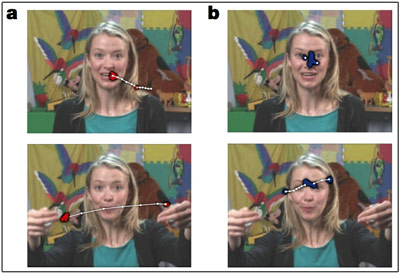
THIS ARTICLE IS MORE THAN FIVE YEARS OLD
This article is more than five years old. Autism research — and science in general — is constantly evolving, so older articles may contain information or theories that have been reevaluated since their original publication date.
Identical twins, who have virtually the same genetic material, show highly similar patterns of eye movements when looking at faces. Fraternal twins, who have about half their genes in common, show less similar gaze patterns.
The unpublished findings suggest that social gaze behavior is largely determined by genetics, rather than by the environment, says lead investigator John Constantino, professor of psychiatry and pediatrics at Washington University in St. Louis. The findings were presented yesterday at the 2016 International Meeting for Autism Research in Baltimore. The study supports the idea that social gaze behavior is a quantifiable behavior, or ‘endophenotype,’ that represents part of the genetic risk for the condition, he says.
The differences are “striking,” says Joseph Piven, distinguished professor of psychiatry, pediatrics and psychology at the University of North Carolina at Chapel Hill, who was not involved in the study. “They make clear the genetic basis of this phenomenon.”
Informed of the findings, others at the meeting expressed responses ranging from surprise to incredulity.
Previous eye-tracking studies suggest that people with autism spend more time looking at mouths than at eyes. The new study hints that this phenomenon has genetic roots.
Constantino’s team used eye-tracking technology to follow the gaze of typically developing 18- to 36-month-old twins: 41 pairs of identical twins and 42 pairs of fraternal twins. The toddlers watched 27 randomly ordered videos of an adult talking or singing nursery rhymes or of fellow toddlers playing. An eye tracker monitored how much time each child spent looking at the eyes and mouths of the people in the videos, and at the videos overall.
Look–alikes:
The researchers found that over the entire set of videos, identical twins spend a nearly identical fraction of time looking at eyes or mouths, whereas fraternal twins are less similar in their focus. Constantino’s team measured the correlations between the twins’ eye movements on a scale from 0 to 1 with higher numbers indicating stronger correlations.
For identical twins, the correlation was 0.9; for fraternal twins, it measured 0.4. In contrast, 42 pairs of unrelated age-matched children showed a correlation of only 0.2. These numbers held up when the twins watched different videos.
The researchers also compared the moment-to-moment gaze behavior of each member of a twin pair for specific 60-second clips. Identical twins showed far more similar tracking patterns than fraternal twins did.
Stefanie Kennon-McGill, the postdoctoral fellow from Constantino’s lab who presented the findings, says the team is following the twins to see whether their gaze behaviors change as they age. The researchers also plan to explore how differences in social gaze relate to other social behaviors, such as communication.
For more reports from the 2016 International Meeting for Autism Research, please click here.
By joining the discussion, you agree to our privacy policy.